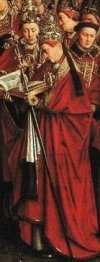 The
Liturgical Year
The
Liturgical Year The
Liturgical Year
The
Liturgical YearThe liturgical calendar Jehan knows weaves Catholic theology, agricultural necessity, and the pagan roots of peasant life together into a whole whose parts difficult to extricate. After the Council of Trent many of the more egregiously pagan elements were purged by the Counter-Reformation church, largely in response to the puritannical pressure of the Protestants who had a strong distaste for the unruly, primitive, and pagan.
Along with the major days marking the liturgical seasons, every day of the year was feast day of some saint. The importance of these days varied from time to time and region to region -- there were plenty of locally-honored saints whose following only spread over a few square miles, as well as saint's days that were major seasonal markers, like St. John's Eve and Michaelmas. The average peasant might not know the date, but he knew when the festivals were. The loss of these festivals was one reason why Protestantism never caught on as much with the peasants as it did with the nobility and the bourgeoisie.
Workshops were closed on Sundays and feast days -- these amounted to over 100 days a year. The average laborer worked about five days a week. When the printers' journeymen went on strike in Lyon, one of their grievances was that they wanted the right to work on feast days. In Protestant countries, where the practice and ethics of capitalism were particularly emerging, more days to work meant more days to make money. In Catholic countries, Protestants usually did not have a choice about observing the feast days -- they were civic holidays, and even in the Edict of Nantes one of the conditions was that Protestants had to observe the feast days. Otherwise, Catholic merchants and shopkeepers would be at a mercantile disadvantage.
On a smaller level of cyclical time, the days of the week were also invested with liturgical significance even though they mostly retained the names of pagan deities (either Latin or Germanic, depending on the language you spoke). Friday (when Christ was crucified) was a fast day, although for most people this made no difference from their regular meatless diet. In towns, butcher's shops and stalls were closed on this day, even in England. The most important day was of course Sunday, the day of the resurrection, a day of rest, and the day for the average person to go to church and socialize. Church served as the major social gathering place -- men checked out the good-looking women, courtships were conducted, government edicts were announced, business was discussed, and rowdy games were played in the churchyard. Only incidentally was the ritual itself paid close attention to, since no one actually understood it anyway. Nevertheless, its magical invocations were comforting. The Protestants took away a lot of the ritual mystery and made church a place to hear and study the Word of God. Members were required to pay attention to the preaching in their own language and actively participate by singing psalms. A good preacher could be very entertaining, but this participation was novel and made many Catholics uncomfortable -- what could those people be up to in their secret meetings?
The microcosm of time, the day itself, was another liturgical cycle. The bells of abbeys and cathedrals rang the hours of Divine Office. The hours begin with Vigils or Matins in the middle of the night (split into three parts, at 9 pm, midnight, and 3 am), Lauds at daybreak, then the four "little hours": Prime (around 6 am), Tierce (around 9 am), Sext (around noon), and Nones (around 3 pm), then the evening Vespers (around 5-6 pm), and the final office of Compline (around 7-8 pm). For the monastic this was the true work of God (opus dei), fulfilling the mandate to 'pray without ceasing.' The desire to benefit from this endless prayer was what made the monasteries rich, as the nobility provided for the future welfare of their own souls by donating property to religious foundations in order to give them the revenue to sustain this spiritual work. By the renaissance, the temptations offered by this wealth had not only corrupted the spiritual life of monasteries, it made an irresistable prize to princes who could enrich their treasuries by a religious conversion.
 The
liturgical year begins with Advent, which starts four Sundays before
Christmas (December 25). The mood of this season is anticipation and preparation,
with an underlaying thread of penitence, awaiting the coming of the Savior.
The Immaculate Conception of Mary is celebrated December 8. This is the
season when the harvest has been gathered in and put up in the larder,
and the seed has been sown for the next spring. In books of hours, December
is the time to slaughter the pigs and turn them into a year's worth
of ham, bacon, sausage, pâté, lard, pickled pig's feet, and
innumerable other products. The days get short and people stay close to
home.
The
liturgical year begins with Advent, which starts four Sundays before
Christmas (December 25). The mood of this season is anticipation and preparation,
with an underlaying thread of penitence, awaiting the coming of the Savior.
The Immaculate Conception of Mary is celebrated December 8. This is the
season when the harvest has been gathered in and put up in the larder,
and the seed has been sown for the next spring. In books of hours, December
is the time to slaughter the pigs and turn them into a year's worth
of ham, bacon, sausage, pâté, lard, pickled pig's feet, and
innumerable other products. The days get short and people stay close to
home.
 Christmastide
begins with Christmas Eve (the liturgical day actually begins with Vigils
or Matins, the nighttime office). The darkest day of the year, the winter
solstice (December 22), also marks the beginning of longer days. In northern
latitudes where the seasonal changes in light are profound, it has ancient
pagan roots as a celebration of light. In the classical Mediterranean,
the Roman Saturnalia celebrated at this time was also a holiday of feasting
and gift-giving, enjoying and praying for prosperity. And of course, the
Jewish festival of lights, Hannukah, also occurs this time of year. That
these traditions dovetail so nicely with the celebration of the birth of
Christ, the Prince of Light, is probably no coincidence but a tribute to
the adaptability of early Christianity. Christmas Day is followed by a
number of feast days: St. Stephen (Dec 26), the Holy Innocents (Dec. 28),
the Circumcision
of Christ (Jan. 1), and Epiphany
(Jan. 6), the "twelfth night" of the long Christmas celebration.
Christmastide
begins with Christmas Eve (the liturgical day actually begins with Vigils
or Matins, the nighttime office). The darkest day of the year, the winter
solstice (December 22), also marks the beginning of longer days. In northern
latitudes where the seasonal changes in light are profound, it has ancient
pagan roots as a celebration of light. In the classical Mediterranean,
the Roman Saturnalia celebrated at this time was also a holiday of feasting
and gift-giving, enjoying and praying for prosperity. And of course, the
Jewish festival of lights, Hannukah, also occurs this time of year. That
these traditions dovetail so nicely with the celebration of the birth of
Christ, the Prince of Light, is probably no coincidence but a tribute to
the adaptability of early Christianity. Christmas Day is followed by a
number of feast days: St. Stephen (Dec 26), the Holy Innocents (Dec. 28),
the Circumcision
of Christ (Jan. 1), and Epiphany
(Jan. 6), the "twelfth night" of the long Christmas celebration.
Not everyone celebrated January 1 as the beginning of the new year, but in France this has been the case since the reign of Charles IX. It was the new year, not Christmas, that was the occasion for gift-giving in many places (England and Scotland, as well as France). Other gift-giving occasions might be Epiphany, when the Three Kings brought their gifts to the Christ child, or St. Nicholas' Day (December 6).
Books of hours show January as a time to sit at a groaning board in front of the fire.
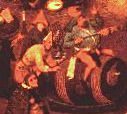 Septuagesima
is a period of three weeks of preparation before Lent. The most interesting
feast days likely to fall during this time are St. Valentine's Day (Feb.
14) and The
Presentation of Our Lord, also known as the Purification of the Virgin
or Candlemas (Feb. 2). Candelmas is one of the ancient Celtic quarter-days
(the others being May 1, August 2, and November 1). The evenings before
these days were ones of great ritual power to the druids (Walpurgisnacht,
Halloween). In some kind of historical irony, Candlemas seems to
have survived into the modern secular world as Groundhog Day. In books
of hours, February
was usually illustrated as a time to sit by the fire with your dog,
while your servant brought in wood for the fire. The cutting of willow
branches for making fences and walls was one of the traditional activities.
Lambs (and kids, calves, etc.) are born around this time and the pagan
precursors of Candlemas celebrate that.
Septuagesima
is a period of three weeks of preparation before Lent. The most interesting
feast days likely to fall during this time are St. Valentine's Day (Feb.
14) and The
Presentation of Our Lord, also known as the Purification of the Virgin
or Candlemas (Feb. 2). Candelmas is one of the ancient Celtic quarter-days
(the others being May 1, August 2, and November 1). The evenings before
these days were ones of great ritual power to the druids (Walpurgisnacht,
Halloween). In some kind of historical irony, Candlemas seems to
have survived into the modern secular world as Groundhog Day. In books
of hours, February
was usually illustrated as a time to sit by the fire with your dog,
while your servant brought in wood for the fire. The cutting of willow
branches for making fences and walls was one of the traditional activities.
Lambs (and kids, calves, etc.) are born around this time and the pagan
precursors of Candlemas celebrate that.
The last day before Lent is Shrove Tuesday (Mardi Gras), the last good meal for a while. It is celebrated by a riotous Carnival, featuring themes of inversion, "the world turned upside down", where fools and idiots rule. Customs varied from place to place, but the "Abbeys of Misrule", the election of a "boy bishop" who would hand out play money and dispense satirical justice appear in many towns. Political protest often disguised itself as comical satire, and during the civil wars there were several occasions of Carnivals turning quite violent, including coups that took over the local government. Protestants disapproved of the pagan excesses of gluttony, lechery, and violence that often went with Carnival, and the Counter-Reformation church began to clamp down on the wildness as it tried to purge the subversive folk elements from common practice. Waffles are a customary Carnival-time food.
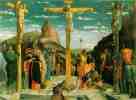 Lent
begins on Ash Wednesday (40 days before Easter), between Feb. 4 and
Mar. 10). The ashes, made from burning the palms from the previous year,
are smeared on the faithful as a reminder of mortality. Lent is a season
of fasting and penitence. No meat can be eaten. For the average poor peasant
this was no different from usual, except that he couldn't throw a bit of
lard in the pot. In some parts of France, Ash Wednesday meant scrubbing
out the pots and skillets with sand to get rid of any traces of cooking
fat. It's a time that coincides with declining food supplies in any case,
when food needs to be conserved to get through until summer.
Lent
begins on Ash Wednesday (40 days before Easter), between Feb. 4 and
Mar. 10). The ashes, made from burning the palms from the previous year,
are smeared on the faithful as a reminder of mortality. Lent is a season
of fasting and penitence. No meat can be eaten. For the average poor peasant
this was no different from usual, except that he couldn't throw a bit of
lard in the pot. In some parts of France, Ash Wednesday meant scrubbing
out the pots and skillets with sand to get rid of any traces of cooking
fat. It's a time that coincides with declining food supplies in any case,
when food needs to be conserved to get through until summer.
Noteworthy feasts during Lent include St. Joseph (Mar. 19) and the Annunciation, or Lady Day, on March 25 (9 months before Christmas and very near the spring equinox, Mar. 21). In many parts of Europe, Lady Day was the start of the New Year. France which did not standardize on January 1 as the start of the new year until the reign of Charles IX.
Lent culminates in Holy Week, which celebrates in great detail Christ's final days on earth. It begins with Palm Sunday and Christ's entry into Jerusalem, celebrated with the blessing and distribution of palms. These were kept in houses as a blessing for the rest of the year. On Maundy Thursday the Last Supper is celebrated. Good Friday, the most solemn day of the year, commemorated the crucifixion. Penitents would often march in processions, flogging themselves or carrying the cross in commemoration of Christ's suffering. Even in Protestant countries, business was suspended -- to this day, the stock market is closed. The vigil on Holy Saturday was a rich liturgical celebration, with the blessing of the huge Pascal candle (destined to burn continuously for 40 days). At daybreak on Easter Sunday morning, the bells erupted with joy.
The traditional activity of March in books of hours is the pruning of the grape vines. March is also time to plow and sow the spring crops, like oats.
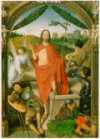 Eastertide
is the most joyous of Christian holidays, beginning with the resurrection
of Christ on Easter Sunday (between Mar. 22 and April 25). The Easter season
lasts 40 days until Ascension
Thursday. The liturgy is full of Alleluias. During this time, Christ
walked the earth to strengthen the faith of his apostles before returning
to heaven once and for all. Pagan traditions from Tammuz and Adonis
to the Celtic Green Man are full of the theme of the resurrection of the
son/lover of the Earth Mother, and the rebirth of life in the spring.
Eastertide
is the most joyous of Christian holidays, beginning with the resurrection
of Christ on Easter Sunday (between Mar. 22 and April 25). The Easter season
lasts 40 days until Ascension
Thursday. The liturgy is full of Alleluias. During this time, Christ
walked the earth to strengthen the faith of his apostles before returning
to heaven once and for all. Pagan traditions from Tammuz and Adonis
to the Celtic Green Man are full of the theme of the resurrection of the
son/lover of the Earth Mother, and the rebirth of life in the spring.
The lambs born in February are just in time for the traditional Passover/Pascal feast. This is hatching season for domestic fowl as well, and although they aren't ready to eat yet, their appearance is always an encouraging reminder of future Sunday dinners. The "easter egg" is ancient fertility symbol with a long pre-Christian history. The traditional activity in books of hours for April is gathering flowers. For the cook, that means tender young potherbs and salad.
Mayday (May 1) falls during the Easter season. Officially the feast of Sts. Philip and James the Apostle, it was the ancient pagan holiday of Beltaine, the beginning of summer. It was celebrated by dancing around maypoles and going into the woods to gather greenery for garlands. These all-night expeditions into the woods involved all sorts of springtime hanky-panky in which fertility was quite enthusiastically celebrated. It was quite typical to be baptising a lot of babies round about the following February. Protestants and Counter-Reformation Catholics alike disapproved of "going a-maying" and eventually managed to stamp out most of its licencious behavior in the course of the next two centuries. In its modern incarnation it is a holiday for labor in most of Europe, a kind of testimony to is anarchic roots.
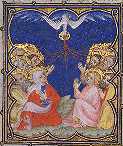 Pentecost
(Whitsunday) occurs seven weeks after Easter and celebrates the descending
of the Holy Spirit on the Apostles and the beginning of the Christian Church.
This holiday was important to Protestants, who took the gift of the Holy
Spirit as symbolizing the "priesthood of all believers." The time after
Pentecost is the longest liturgical season, lasting from now until
Advent. It is the "ordinary time" of the church and coincides with the
ordinary business of rural life: sheep-shearing, haymaking, the harvest,
as well as prime campaign season for making war.
Pentecost
(Whitsunday) occurs seven weeks after Easter and celebrates the descending
of the Holy Spirit on the Apostles and the beginning of the Christian Church.
This holiday was important to Protestants, who took the gift of the Holy
Spirit as symbolizing the "priesthood of all believers." The time after
Pentecost is the longest liturgical season, lasting from now until
Advent. It is the "ordinary time" of the church and coincides with the
ordinary business of rural life: sheep-shearing, haymaking, the harvest,
as well as prime campaign season for making war.
There are a number of holidays of interest that occur around this time. The Sunday after Pentecost is Trinity Sunday, and the Thursday after that is the Feast of Corpus Christi (the Blessed Sacrament). This last holiday was often a volatile one during the Civil Wars. The Eucharest was usually carried in procession, and people were expected to hang out decorations along the route, take off their hats, and kneel when it went by. The argument over the nature of the Eucharest was a vehement one for the reformers, who held that the sacrament only symbolic and that to revere the host as being Christ's actual body was idolatrous. These processions often led to riots, either because Protestants would insult the host or because Catholics would work themselves up to purge their locality of disrespectful heretics.
Another important feast was the birthday of St. John the Baptist on June 24. St. John's Eve was a time for lighting bonfires and celebrating through the night. It coincides fairly closely with the summer solstice (June 22), an ancient pagan holiday involving the lighting of bonfires through the night. From now on, the ancient forces of light begin to lose out against the forces of darkness as the days get shorter.
Lammas (August 2) is another of the major pagan Celtic holidays. It seems to have left little corresponding trace in the modern secular world. The Transfiguration of Christ is celebrated on August 6. The Assumption of the Virgin Mary, a major holy day, is celebrated on August 15. And of course, a day Jehan won't ever forget, St. Bartholomew's day is August 24.
The summer activities in books of hours are usually haymaking and sheep-shearing in June, the harvest in July, and threshing the grain in August. After the June shearing, sheep that are no longer productive, as well as yearling males, might be slaughtered for mutton for the stewpot. Up until the harvest was taken in and brought to market in July/August, food supplies could still be tight. The months of spring and early summer, encouraging because of the fine weather and long days, were also potential times of civic disturbance in the towns after years of poor harvest.
 In
September, Michaelmas (Sept 29), the feast of St. Michael and all the angels,
was the traditional start of the academic year, the London theatre season,
and often the end of the campaign season. It is the start of the hunting
season for deer and other large game. It more or less coincides with the
autumnal equinox (Sept. 23). The birth of the Virgin Mary is celebrated
September 8 and the finding of the Holy Cross September 14.
In
September, Michaelmas (Sept 29), the feast of St. Michael and all the angels,
was the traditional start of the academic year, the London theatre season,
and often the end of the campaign season. It is the start of the hunting
season for deer and other large game. It more or less coincides with the
autumnal equinox (Sept. 23). The birth of the Virgin Mary is celebrated
September 8 and the finding of the Holy Cross September 14.
In books of hours, September is also the time of the grape harvest, at least for most of France. Grapes do not grow in the northwest provinces. The Ile de France and Champagne represent their northernmost range. The Calaisis, Picardy, the Low Countries are all in the northern "beer zone," while the preferred beverage in Normandy is cider.
The last Sunday in October is the feast of Christ the King. This is followed by All Saints' Day (All Hallows' Day) on November 1, another of those old pagan quarter days (Samhain). For the Celts, this day was the end of summer and the start of the new year. This "day between the years" was one of great ritual power to the ancient druids, when the fabric between life and death, the physical and the spiritual, was thin. All Hallow's Eve (Halloween) was a another time for pagan hijinks among the common people. Of all the ancient pagan holidays, this one has left the strongest mark on the modern world. All Saints' Day is followed by All Souls' Day (Nov. 2), when all of the dead are remembered.
In books of hours, October is time to sow the winter grain crop, and November is time for the acorn harvest. Acorns naturally grew in the woods, and served to fatten the pigs just before slaughtering time in December.
